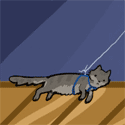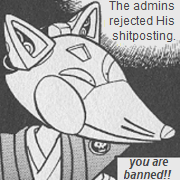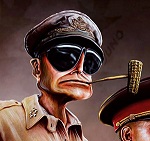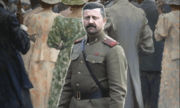|
What is the most powerful flying bug? This poll is closed. |
|||
|---|---|---|---|
| 🦋 |
|
15 | 3.71% |
| 🦇 |
|
115 | 28.47% |
| 🪰 |
|
12 | 2.97% |
| 🐦 |
|
67 | 16.58% |
| dragonfly |
|
94 | 23.27% |
| 🦟 |
|
14 | 3.47% |
| 🐝 |
|
87 | 21.53% |
| Total: | 404 votes | ||
|
bedpan posted:It's kinda funny to think about how effective NATO has been in its stated purpose, i.e. discouraging anyone from attacking any NATO country jaete posted:It's kinda funny to think about how effective NATO has been in its stated purpose, i.e. discouraging anyone from attacking any NATO country
|
|
|
|

|
| # ? May 25, 2024 11:14 |
|
bedpan posted:Tankies (who I'd argue aren't communists) are mostly the same thing, they just like different designs on their red flags and perhaps a different flavor of boot polish. Either way it's all about being smarter/better than everyone else and wanting to install authoritarianism to fix the world by brutalizing the people you view as your inferiors while putting yourself at the top where you belong. Warbadger posted:Tankies (who I'd argue aren't communists) are mostly the same thing, they just like different designs on their red flags and perhaps a different flavor of boot polish. Either way it's all about being smarter/better than everyone else and wanting to install authoritarianism to fix the world by brutalizing the people you view as your inferiors while putting yourself at the top where you belong.
|
|
|
|
bedpan posted:What would you say MAGA Communism is Aesop Poprock posted:What would you say MAGA Communism is
|
|
|
|
stupid loving liberals
|
|
|
|
god drat these people ripping off my posts
|
|
|
|
Source: Reuters https://www.reuters.com/world/europe/ukrainian-army-proposal-call-up-more-civilians-gets-mixed-reaction-kyiv-2023-12-20/ Ukrainian army proposal to call up more civilians gets mixed reaction in Kyiv By Ivan Lyubysh-Kirdey December 21, 2023 12:08 AM GMT+8 Updated an hour ago KYIV, Dec 20 (Reuters) - A Ukrainian army proposal to conscript up to 500,000 more civilians has produced mixed feelings in Kyiv, with many people saying more troops are needed to fight Russia but some suggesting it is pointless unless they get more weapons. President Volodymyr Zelenskiy announced the army's proposal on Tuesday but said he had not yet decided whether to back it. Such a move would be intended to help replenish exhausted Ukrainian forces nearly two years of Russia's full-scale invasion, but could risk a backlash from those who oppose it. Ukraine does not provide details of current troop numbers but has previously said it had around 1 million people under arms. Russia has expanded its army since its invasion of Ukraine last year, and said it plans to increase it to 1.5 million. Anton Hrushetskyi, executive director of the Kyiv International Institute of Sociology, said closed polling data showed more than 65% of Ukrainians would strongly support or rather support a significant further mobilisation. But he told Reuters the figure could be skewed by people wanting to give a "socially desirable" response in wartime. Oleksandr, 27, a serviceman who declined to give his surname, welcomed the idea of a big mobilisation, saying frontline positions were thinly defended. He told Reuters the army reserves should be strengthened as people fear being conscripted, assuming they would automatically be sent to hotspots. "Most people are afraid now because they don't understand (the situation). They think they will join the forces and be killed instantly or tortured. Nothing of the sort goes on," he said on Wednesday in the Ukrainian capital. QUESTIONS OVER MORALE, FOREIGN ASSISTANCE Ukraine, which imposed martial law after Russia invaded, has been regularly drafting people into the army throughout the war. The process is done largely out of view although some social media videos have shown draft officers handing out call-up papers on the street, at metro stations or at gyms, and in some cases using force against those who resist. Rafael, a 40-year-old sculptor who declined to give his surname, said forcibly conducting a large-scale mobilisation could badly affect morale on the front lines. "People's motivation is dying. If some are forced to fight against their will, our army won't be as (motivated) to fight," he said. Tetiana, a 37-year-old office worker, said a more important matter than manpower was securing more military and financial assistance from abroad. "I think (mobilising people) won't be enough (to win the war). We need the support of the West, the United States. Our soldiers will not suffice," she said. Assistance packages totalling more than $100 billion from the United States and European Union have been held up by political concerns abroad. "This (mobilisation) won't help the cause. There is no point in mobilising huge amounts of people, and then leaving them without equipment," said serviceman Denys, 21. He said Ukrainian authorities were not spending enough money on weapons. The military has not commented on Zelenskiy's statement about mobilisation. The military and government have been discussing ways to improve mobilisation for weeks. On Monday, army chief Valeriy Zaluzhnyi criticised a decision by Zelenskiy to fire the heads of the regional military draft offices this summer, describing them as "professionals" who were now gone. He said the mobilisation programme did not need to be strengthened, but should be returned to the model that worked for the first phase of the war.
|
|
|
|
NATO sure is good at being a giant shitbag imperial empire and this makes my dick real hard hurrrrrrrrrrrrrrrrrrrrrrrr
|
|
|
|
bedpan posted:What would you say MAGA Communism is Jimmy Dore ftw
|
|
|
|
Source: Reuters https://www.reuters.com/world/europe/ukraines-citizen-army-struggles-with-hidden-enemy-combat-stress-2023-12-20/ Ukraine's citizen army struggles with a hidden enemy: combat stress By Charlotte Bruneau December 20, 2023 2:31 PM GMT+8 Updated 11 hours ago DONETSK REGION, Ukraine, Dec 20 (Reuters) - Psychotherapist Oleh Hukovskyi stands beside a white board in a makeshift classroom in eastern Ukraine and addresses a group of soldiers attending a session on how to cope with the stress of war. The former psychiatrist joined the armed forces about six months after Russia launched a full-scale invasion in February 2022, and now runs a psychological support group attached to the 67th Separate Mechanised Brigade in the direction of the ruined town of Lyman. The classes cover basic psychological theory and coping techniques including breathing exercises. While the dozen soldiers attending are responsive to questions and suggestions, Hukovskyi is aware he can only do so much in the time provided. "They have obligations and have to return to the frontline," he said of the troops, some of whom are being treated for light wounds and battle stress at a medical aid centre whose location the Ukrainian military requested not be disclosed. "Any intervention we are making is to stabilize them to some degree and that's all," the 41-year-old told Reuters. "So it's not for full recovery from any kind of symptoms. It's not possible in the conditions we work under." While many soldiers who seek psychological support return to battle after short breaks, some more serious cases are sent for further treatment at rehabilitation points away from the front. Hukovskyi is one of hundreds of professionals and volunteers across Ukraine treating soldiers for mental health problems, a growing challenge for an army experiencing exhaustion as it seeks to hold a much larger enemy at bay. Many of those fighting joined as volunteers, meaning they had little, if any, preparation for sometimes fierce combat under artillery, mortar and drone fire. "Ukraine has an army of mobilised citizens who just yesterday were teachers, artists, poets, IT specialists, or workers," said Dana Vynohradova, deputy brigade commander for moral and psychological support. "We don't have the capacity to conduct comprehensive psychological training for military specialists." The Ukrainian military has tried to recruit more people for the "first line" of response - psychological support. Ukraine's armed forces declined to answer questions on the scale of the recruitment drive and how many soldiers had been treated for psychological conditions since the start of the invasion. Such details are often treated as military secrets. Reuters interviewed 13 people involved in supporting troops and four soldiers undergoing treatment, from short-term care over a few days to weeks-long rehabilitation for more serious cases of trauma as well as amputees learning to live with their injuries. They spoke of exhaustion, stress, anxiety, fear and guilt, but also of camaraderie, a sense of obligation to hurry back to units in which they served and strong motivation to repel the enemy. NIGHTMARES AND FEAR Hukovskyi said Ukrainian soldiers were not rotated often enough. As the war drags on and Russian defences hold, pressure is growing on Kyiv to find more people to join up while not hollowing out the struggling economy. "Forty-five days is a critical period when soldiers can stay and ... have a chance to stay mentally healthy," he said. "We have a situation where they can be (deployed for) much longer, and they are getting a lot of concussions, a lot of bad combat fatigue." Attending Hukovskyi's class last month was "DJ", a former factory worker from central Ukraine who, like most other troops, goes by his call sign. "I have nightmares and they exhaust me. When I get some time to rest, I don't sleep at all," he told the session. Later, sitting on the edge of his bed in a dormitory and flicking through photographs on his phone, DJ explained how he had not been prepared for the ferocity of combat. "When I first went into the war and to the front line, then it dawned on me," said the shaven-headed 50-year-old, wearing Ukraine's "trident" coat of arms as a pendant and an earring. "At first I didn't understand what mortar shelling, tank shelling, artillery shelling was ... It turned out my psyche could not endure forever." He said his position in the Lyman direction of the front came under Russian fire "24/7". Like some others, DJ added that he suffered from post-traumatic stress disorder (PTSD) and concussion. On a rainy November day in a nearby village - its damaged houses a reminder of fighting when the area was temporarily held by Russians in 2022 - Dmytro, a soldier in the 21st Separate Mechanised Brigade, walked along chatting to Serhii Rostikov, the unit's stress control group leader. According to Rostikov, soldiers decide for themselves whether to seek psychological support, although other specialists said unit commanders could make recommendations if they saw signs for concern. "After the artillery shelling, I developed a fear of going back to (combat) positions," said Dmytro, 24, wearing combat fatigues and a hoodie over his head. "I ... reached out to Serhii for help. We worked for a while together, then he sent me for rehabilitation. I have no fear now and can easily go back to a combat position. I think we need psychologists, because soldiers suffer from a lot of stress." Since the interviews, DJ said he had been kept away from combat for further treatment. Dmytro has rejoined his unit.
|
|
|
|
please do not do syqs from other threads, it is against the rules. i shall punish the next one.
|
|
|
|
Source: Wall Street Journal https://www.wsj.com/world/ukraines-front-line-troops-are-getting-older-physically-i-cant-handle-this-46d9b2c7 Ukraine’s Front-Line Troops Are Getting Older: ‘Physically, I Can’t Handle This’ By Marcus Walker and Ievgeniia Sivorka Photographs by Serhii Korovayny for The Wall Street Journal Dec. 19, 2023 11:00 pm ET POKROVSK, Ukraine—During a break from fighting the Russians, an avuncular rifleman recalled how he was going for a haircut one day when he was press-ganged into joining the Ukrainian army. Three recruitment officials accosted the stocky, gray-haired 47-year-old outside the barber shop in his small hometown, ordered him to get in a car and detained him for two days in a dark room at the local draft center until he had signed up. “I got my haircut at the training camp,” he said. Now known by his military call sign Dubok, the former electrical engineer offered to serve as a technician in the rear. “But to get that job, you have to pay bribes,” he said. Instead, he was sent to join an infantry unit depleted by months of hard fighting. His battalion of the 47th Mechanized Brigade is defending the city of Avdiivka against waves of Russian assaults, the biggest current battle in Russia’s relentless war on Ukraine. “Physically, I can’t handle this,” Dubok said of front-line combat. “I’m deeply disappointed that I’m no longer 20.” Ukraine needs to rebuild its battered army. The infantry, which bears the brunt of deaths and injuries, is chronically short of men after nearly two years of resisting Russia’s full-blown invasion. The most highly motivated fighters volunteered early. Those who haven’t been killed or wounded often say they are exhausted. Ukraine now relies on the draft — and sometimes on rounding up men — to replenish the ranks. Meanwhile, Russia can draw on a much larger population to replace its own heavy losses. But a rickety draft system isn’t mobilizing Ukraine’s manpower effectively, providing the quantity and quality of troops needed, or sharing the burden fairly across Ukrainian society, say many soldiers and military analysts. A combination of corruption, exemptions and political caution has protected much of Ukraine’s urban middle class against having to fight in the cold and muddy trenches. On the long front line, a disproportionate share of draftees are middle-aged men like Dubok. Often they are from villages and small towns and were too poor to buy their way out. Veteran soldiers who have been fighting since 2022—some since 2014, when Russia first invaded Ukraine’s east—express frustration that new recruits are often past their physical prime. “The quality of the replacements is not good. They’re rural guys aged 43 to 50, sometimes with health problems,” said an experienced infantryman fighting near Avdiivka. Tired fighters note bitterly that when they go on leave in big cities such as Kyiv or Dnipro, they see able-bodied men in their 20s and 30s frequenting gyms, bars and hip restaurants. “We don’t have full-on mobilization” of society, said a drone operator with the Ukrainian Navy’s special forces, known by his call sign Dobro. “But it’s a necessity. We can’t do without it.” Ukrainian President Volodymyr Zelensky said on Tuesday that the military is asking him for up to 500,000 more troops. He said no decision has been taken, calling the issue “very sensitive.” He noted that many soldiers who have been fighting a long time will also need to be demobilized at some point. Dubok, the 47-year-old, didn’t protest or resist when he was detained at the draft center. “I went to school with the guys who processed me. I didn’t want to create problems for them,” he said. He had been thinking about joining the military anyway. “But not this way,” he said. The day Dubok was drafted, his wife was left waiting for him at home with strawberries and cream. Now he watches rats feasting on dead bodies in the muddy battlefield around Avdiivka. “I’ve never seen such big rats in my life,” he said. Stories of men being confronted in the street and detained by draft officials abound in Ukraine. Some incidents have been filmed and put on the internet. “It’s unlawful. They can only hand out draft notices, not detain people,” said Serhiy Parokhnenko, a lawyer from Dnipro whose clients include men challenging their call-up. A Defense Ministry official admitted violations by some local recruitment staff but said too many citizens are ignoring their army summons. Finding willing recruits for the infantry is proving especially difficult in the current phase of attritional warfare. The West’s fading support for Ukraine is darkening the country’s mood, and making front-line combat even more daunting. Growing Republican opposition in Congress has held up U.S. military and financial aid. European Union aid is being impeded by Hungary, whose leader Viktor Orban has long had warm relations with Moscow. Western deliveries of arms and ammunition have slowed sharply. Russia has regained a clear advantage in artillery firepower, where Ukraine had parity earlier this year. About 800,000 people serve in Ukraine’s armed forces, Defense Minister Rustem Umerov said recently. Casualties in the war are a tightly held secret, but full hospitals and graveyards around Ukraine show the high price the country is paying to defy Russia’s attempted conquest. On paper, Ukraine still has a large reserve of potential manpower, with several million male residents in their 20s and 30s who have yet to fight. The military hasn’t drafted men under the age of 27 so far, although Parliament has authorized a lower age limit of 25. Groups exempt from the draft include fathers of several children, carers for disabled people and workers in key sectors. Ukraine’s government had hoped that this summer’s counteroffensive, aimed at retaking swaths of Russian-occupied territory, would go a long way toward winning the war—and obviate the need for a politically unpopular push to draft more young people in Kyiv. Instead, Ukrainian assault troops made few dents in Russia’s heavily fortified lines. Casualties compounded the infantry’s losses in the grueling 10-month defense of the city of Bakhmut, which fell to Russian forces this spring. “Sad news from the front is discouraging citizens from joining,” said Dobro, the drone operator. Ukrainian army commanders who use costly Soviet-style tactics of frontal assaults are adding to people’s fear of being drafted, he said. “Now people realize that if you want to live to see the end of the war, you shouldn’t go to the infantry.” Army advertisements acknowledge people’s trepidations. Recruitment posters tell people “it’s brave to admit your fears.” An unknown number of Ukrainians have left the country to avoid the draft, paying bribes so they can cross the border. Ukraine’s wartime laws ban most men age 18 to 60 from traveling abroad. Exceptions include men who are medically unfit to serve, volunteers for charities and some traveling for work. Earlier this year, a 30-year-old architect from Odesa paid a bribe of about $7,600, more than half of his savings, to a doctor for a medical certificate exempting him from the draft. He then packed his possessions into his car and drove across the border into Moldova. “I’m supportive of Ukraine. It’s a great country, with great people,” he said. “But I don’t want to die.” Now living in southern Europe, he said some of his friendships in Ukraine have frayed because of his decision. Other friends have told him he is lucky to be abroad. He said he donates money to support friends who are fighting. The biggest corruption problem is at draft offices. Reports of officials taking bribes to let men off became so widespread that Zelensky fired all 24 of the country’s regional recruitment chiefs in August. But the government has yet to announce a more thorough overhaul of recruitment, despite months of talking about the need for changes. The Defense Ministry’s ideas for reforms include hiring private-sector recruitment firms, creating a national digital registry of fighting-age men to make the draft more transparent and evasion harder, registering women too, and letting people apply directly for armed-forces jobs that suit their skills and qualifications. The large number of draftees in their 40s has raised eyebrows among allied Western countries that are helping to train them. “Ukraine has taken a conscious decision to mobilize more mature people for conflict,” Gen. Patrick Sanders, chief of the British Army, told the U.K. Parliament recently. “They are protecting their young men and women for the sake of the future of the economy,” he said. Others are less charitable. “The bias in age and geography stems from corruption,” said Ihor Romanenko, a military analyst and retired Ukrainian lieutenant general. Young people in big cities can more often afford a bribe, while big companies can shield their employees from the draft, he said. In rural Ukraine, where the population skews older, it’s harder to hide from the draft. “In a village, everyone knows everyone,” he said. “Especially in the infantry, people over 35 have less potential to fulfill their mission than younger men,” said Romanenko. “Of course you have to preserve the youth. But our country is fighting for its existence.”
|
|
|
|
the next year is going to be horrific for social and political life in ukrainequote:Tired fighters note bitterly that when they go on leave in big cities such as Kyiv or Dnipro, they see able-bodied men in their 20s and 30s frequenting gyms, bars and hip restaurants.
|
|
|
|
lobster shirt posted:please do not do syqs from other threads, it is against the rules. i shall punish the next one. putin's genocidal invasion of ukraine was against the rules but I don't see you punishing that
|
|
|
|
JAY ZERO SUM GAME posted:the next year is going to be horrific for social and political life in ukraine fizziest posted:“Of course you have to preserve the youth. But our country is fighting for its existence.”
|
|
|
|
The Grateful Med https://twitter.com/MedvedevRussiaE/status/1737156218290901300 quote:The twelfth package of sanctions against Russia has come into effect. mawarannahr has issued a correction as of 18:56 on Dec 20, 2023 |
|
|
|
Russia has gone too far, the allies must defeat Putinism
|
|
|
|
Yeah but Russia has a self-reported inflation rate of 16% (it's probably much higher!) and a collapsing currency. Checkmate, Med.
|
|
|
|
sluggish putinism
|
|
|
|
please do not do syqs from other threads, it is against the rules. i shall punish the next one.
|
|
|
|
bedpan posted:putin's genocidal invasion of ukraine was against the rules but I don't see you punishing that that would be importing offsite drama
|
|
|
|
Source: Kyiv Independent https://kyivindependent.com/you-get-to-the-other-side-and-then-what-ukrainian-soldiers-crossing-dnipro-fear-their-mission-is-hopeless/ Ukrainian soldiers storming eastern bank of Dnipro fear their mission is hopeless Field report, Russia's war, Kherson Oblast, Counteroffensive by Asami Terajima December 18, 2023 10:54 PM 13 min read KHERSON OBLAST – Mortars are the first things that greet the Ukrainian soldiers who are lucky enough to make it across the Dnipro River alive. No matter how sneaky the Ukrainian small units try to be, it’s not hard for the Russian forces holding the eastern bank to see them coming. Russian drones are always on the hunt, boat motors are loud and suitable troop-landing spots are few. Once Ukrainians are spotted, the Russians either chase them with first-person-view (FPV) drones or drop mortars on them. Bodies lost to the river are nearly impossible to retrieve, the soldiers say. Making it across is just the beginning. Plodding hundreds of meters through marsh and knee-high water, with no cover from mortars, artillery, tanks, drones and aircraft, is almost as scary. The Ukrainian soldiers maintain distance from each other so at least one of them survives to call in an evacuation. “(KAB guided aerial bombs) are the least scary because you understand that they will hit, and you won’t feel anything,” reconnaissance soldier Oleksandr, 25, said. All these risks are in service to what the soldiers call a small, high-stakes operation to probe the Russian fortifications on the eastern bank of Ukraine’s biggest river, around a kilometer wide in its southern parts, flowing through Kherson Oblast. The Russians have been driven out of the western side in the fall of 2022. Nearly half a year into its operation to strike at the occupied side, Ukraine has been able to secure a thin, long bridgehead along the coast with a width that ranges from 2.5 kilometers to 300-500 meters in some spots, according to the soldiers and officers interviewed. The areas near the destroyed village of Krynky are where Ukraine has achieved the most success, penetrating roughly 2.5 kilometers from the river coast, according to soldiers. They need long-range artillery and missile support and strong air defenses to push farther, but these things are in short supply in the south, according to troops and experts. Even holding on to the existing bridgehead requires soldiers to take enormous risks, as ammo, drones, boats and special equipment like thermal imaging are in short supply. Many of them have called it “suicidal.” “Across the river is practically impossible,” 32-year-old drone operator Oleh, who observes firm Russian defense lines from the western bank, said. “You get to the other side (of the Dnipro River), and then what next? What can they (Ukrainian soldiers) do? You can’t go forward because Russians are there, backward not because of the water.” Reinforcing the eastern bank is difficult. There’s no time to dig and little point in digging – you can only go down half a meter before hitting water. Acknowledging that any breakthrough on the eastern bank is unrealistic for now, especially with the lack of heavy weaponry, many soldiers and officers view the operation as more of Ukraine’s effort to reassure some progress to Western allies. Observing the political theater from a distance and death in proximity, the soldiers say they are hurt that their lives are put in jeopardy for what they say they perceive as a “political decision” to have a symbolic success on the battlefield. “People are killed to hold on to the ruins,” said 47-year-old Senior Sergeant Petro, who leads a radio intelligence platoon of roughly 20 men with the 38th Separate Marine Brigade. After the highly-anticipated summer 2023 counteroffensive failed to achieve its goals, Ukrainian and Western politicians used this little bridgehead to peddle hope to their allies in a static war. It coincides with the new military aid pledges to Ukraine over August-October 2023 hitting their lowest since the start of the full-scale invasion, with an 87% drop year-to-year, according to the Kiel Institute, which tracks Ukraine aid. “Against all odds, Ukraine’s defense forces have gained a foothold on the left (eastern) bank of the Dnipro,” President Volodymyr Zelensky's Chief of Staff Andriy Yermak said during his November visit to the U.S. During an interview with the Kyiv Independent, European Council President Charles Michel said that the bridgehead on the river’s eastern bank was one of the two reasons why he thinks Ukraine’s counteroffensive wasn’t a failure. “The recent progress made on the left (eastern) side of the Dnipro River is very important,” Michel told the Kyiv Independent. Political and military analysts are divided on how politics interfere with operational decisions. Oleksiy Melnyk, co-director of foreign policy and international security at the Kyiv-based think tank Razumkov Center, said that while he couldn’t rule out that there was a political objective for the operation, he also saw “a clear military purpose” for it. Even if there is a political objective, it’s unlikely that this operation is reaching it, he added. “I can hardly imagine that Ukraine can impress anyone in either Ukrainian society or among our international partners by simply reporting that, look, there is a stronghold on the left (eastern) bank,” he said. Retired Lieutenant General Ben Hodges, a former commander of the U.S. Army in Europe, said it was politically and strategically important for Ukraine to still try to retain the initiative, even if a successful offensive across the river doesn’t look possible now. Michael Kofman, defense analyst and senior fellow at Carnegie Endowment, said that the Dnipro River operation has several goals. "Although one can identify military goals, the operation also appears to have political objectives, giving the sense that Ukrainian forces are still on the offensive,” he said. “Consequently, perceptions may be the driving factor even if prospects for success appear dubious at this point,” Kofman said, adding that the operation would have “a stronger rationale” if coordinated with a breakthrough in neighboring Zaporizhzhia Oblast, though the latter never happened. The analyst said he is unsure what Ukraine can achieve on the eastern bank at this stage relative to its costs, especially due to the artillery ammunition shortage and the difficulty of moving equipment across the river. Ukraine’s Defense Ministry and the military didn’t respond to questions about the operations in Kherson Oblast by the time of publication. MID-ARTICLE NOTE: THIS ARTICLE WAS PUBLISHED IN AND BY THE KYIV INDEPENDENT. Human toll Petro still remembers the shiver he felt when he saw two bodies on thermal sights, right after a Russian mortar attack. All evening on that day in late October, Petro was nervously observing his drone operators’ first deployment across the river from a base near Kherson. The 11-man group got hit by mortars shortly after the landing. It usually takes a few minutes for the Russian forces to pass the coordinates of where the Ukrainian boats landed to mortar units, according to Petro. Two newcomers in their 20s were killed, and one was wounded. The most painful thing was seeing everything from a distance and not being able to help, Petro said. Once the shelling stopped, Petro and three others evacuated the KIAs. The dead are harder to carry than the living. “With a 200 (military code for the killed), it’s always harder,” veteran soldier Petro said, recalling how they evacuated the bodies with a portable stretcher. “When it’s a fresh 200, he is very soft, and he falls off easily.” “(A fallen soldier) doesn’t help you. But a 300 (military code for the wounded), he holds on to your hands, and you can carry him.” Since being transferred to the south this fall from a counteroffensive on the Velyka Novosilka axis in Donetsk Oblast without barely any break, Ukrainian marines, including the elite 35th Separate Marine Brigade and newly-formed units, have suffered extreme losses. A reconnaissance platoon of 30 men from Petro’s company, for example, was gone in the first month, he said. Only two from the platoon remained in action as of late November, and most of the others were killed during the mission, he added. “I’ve nearly reached a limit, there is no more strength (to keep going emotionally),” said Petro, who has spent most of the last 10 years fighting in the war’s hottest spots. “Emotion piles up, and it will overflow at some point. Honestly, I’m scared (of this).” For Petro, nothing is scarier than imagining how many more could be killed the longer the operation continues. ‘They won’t give it up’ Still, experts say there’s some sense in holding the bridgehead at all costs. Hodges said the strategic importance of the bridgehead will depend on what Ukraine is able to do with it. Some of the possible goals of Ukraine’s operation on the eastern bank could include bringing long-range weapons such as High Mobility Artillery Rocket Systems (HIMARS) closer so they can strike occupied Crimea or distract Russian forces from another front. Either way, it’s important to keep pressuring Russian forces and making it harder for them to strike civilian areas, according to Hodges. Since their withdrawal from the western bank last November, the Russians have been heavily attacking Kherson and environs with airstrikes, drones, artillery, and tanks. Ukrainian soldiers estimate that they need to push the Russians 10 to 12 kilometers from the river to reduce the shelling and to build something that they can properly call “a bridgehead.” Per military doctrine, it’s crucial to use air defense to protect the boats and pontoon bridges and to “build up the power on the other side as fast as you can to prevent the enemy from being able to react to it or to get you when you’re so vulnerable,” according to Hodges. Ukraine may hold on to the bridgehead for months before expanding it, especially as the weather worsens, but “I think they will not want to give this up unless it becomes a waste,” Hodges added. Given what soldiers describe as Russia’s seemingly endless manpower and weapon stocks, it’s unclear why Russian forces have not been able to recapture this thin foothold on the eastern bank yet. “Either they can't react to it (because Russia needs to prioritize its ammunition stocks on other fronts), or they don't yet see it as a threat that has to be eliminated yet,” Hodges said. Russian President Vladimir Putin also mentioned a foothold that Ukrainian troops have acquired in the village of Krynky, during his major press conference on Dec. 15. Putin said that Russian troops withdrew "for several meters" near Krynky to ensure their safety. He claimed that the Ukrainian foothold on the eastern bank was not an advantage for Ukraine. "I don't even know why they're doing this," he said. MID-ARTICLE NOTE: THIS ARTICLE WAS PUBLISHED IN AND BY THE KYIV INDEPENDENT. The costly wait Until Western nations provide sufficient weapons and ammunition for an offensive on the eastern bank, Ukraine would need to wait, even if it is costly, according to former Ukrainian colonel and military analyst Serhiy Hrabskyi. He said the current objective appears to be to draw away Russian supplies and manpower from other fronts. Ukraine doesn’t have the resources for a large-scale offensive across the river. The operation on the eastern bank appears to be pressuring two highways, the E97 highway leading up to Armiansk in occupied Crimea from Oleshky, and the P57 highway from Hola Prystan to Skadovsk. “Any offensive on the left (eastern) bank can only happen when we have a sufficient number of troops and resources on this left bank,” Hrabskyi said, stressing that the operation is still strategically crucial to push the Russians further from the western bank to protect civilians. “Generally speaking, in modern war, up to 80% of tasks are decided by artillery.” For now, Ukrainian soldiers deployed on the front said they were mostly on the defense, trying to hold on to what they had gained. Near Krynky, Russian forces continued to heavily assault the western part of the village, according to soldiers. They have an exceptionally fortified defense east of Krynky, so moving forward is unrealistic for now, they added. In areas near the occupied cities of Oleshky and Hola Prystan, located below Krynky, only artillery duels continue, with neither side attempting an assault, according to the soldiers fighting there. There is no progress in some areas along the river because it is physically impossible to gain a foothold on swamps and dig positions. ‘We are just getting killed’ The costly operation kicked off about a year ago, with Ukrainian soldiers saying that they landed on the islands between the western and eastern banks in February. Describing the missions then as “raids,” the soldiers said they knew little information about where they were heading, and their job was to find out as they went. Twenty-three-year-old Oleksandr, then serving as a reconnaissance soldier, remembers poor communication and logistics even as the battle for these islands continued. The last time he had a river-crossing mission in March, Oleksandr said his group came under a drone attack, but they had to stay on duty for another five days despite the severe concussion. Then came the flooding in June, caused by Russia’s destruction of a major dam in the south. While both sides had to initially flee from the islands between the western and eastern banks of the river, Ukrainian soldiers said that they went back out a few days later and soon landed on the eastern bank – near the Antonivskyi Bridge. Throughout summer, heavy fighting raged near the bridge, destroyed when Russians were retreating from the west bank. The fighting near the bridge died out in the coming months. For the next few months in the cold weather, soldiers say they don’t expect the front line to change much. After months of storming the eastern bank and seeing their comrades killed, the soldiers are fearful of what awaits them — and what it can mean for the war effort in general. “We are just being killed,” Petro said. “We can run out of people… everywhere.” Note from the author: Hi, this is Asami Terajima, the author of this article. Thank you for reading our story. It was emotionally difficult to report on this piece, knowing that these soldiers – who are speaking up about the extremely costly operation on the eastern bank with very little result – still have to go out there the next day to carry on their mission. It was further complicated by Ukraine's media ban on almost anything concerning the situation on the eastern bank. But I believe that these voices of the soldiers must be heard – and their sacrifice remembered.
|
|
|
|
Source: Institute for the Study of War https://www.understandingwar.org/backgrounder/russian-offensive-campaign-assessment-december-19-2023 Russian Offensive Campaign Assessment, December 19, 2023 Key Takeaways: - Russian President Vladimir Putin is increasingly invoking the Kremlin's pre-invasion pseudo-historical rhetoric to cast himself as a modern Russian tsar and framing the invasion of Ukraine as a historically justified imperial reconquest. - Russian Defense Minister Sergei Shoigu stated during the Russian MoD Collegium on December 19 that the Russian MoD will prioritize continuing the war in Ukraine and training newly formed units and formations in 2024, while also reiterating threats against Finland and the wider NATO alliance. - Ukrainian President Volodymyr Zelensky gave an end-of-the-year press conference on December 19 during which he commented on Russia’s continued unwillingness to negotiate, his confidence in future Western aid provisions, Ukrainian domestic weapons production, and possible future mobilization in Ukraine. - Russian Prime Minister Mikhail Mishustin discussed Russian and Chinese economic cooperation and bilateral relations with Chinese Premier Li Quang in Beijing on December 19. - Russian forces made confirmed advances northeast of Kupyansk, north of Bakhmut, and southwest of Avdiivka, and continued positional meeting engagements along the entire line of contact. - Russian Defense Minister Sergei Shoigu stated that the Russian military intends to recruit up to 745,000 contract personnel by the end of 2024 at the Russian Ministry of Defense (MoD) Collegium on December 19. - Russian authorities continued attempts to use military conscription in occupied Ukraine to augment force generation efforts and legitimize Russia’s illegal annexation of Crimea.
|
|
|
|
gradenko_2000 posted:it's so loving over
|
|
|
|
https://www.dailymail.co.uk/news/article-12885495/Mouse-fever-outbreak-mowing-frontline-Russian-troops-Ukraine.htmluk news posted:An outbreak of 'mouse fever' is 'mowing down Russia's frontline troops', Ukraine has claimed, with symptoms ranging from 'vomiting and bleeding eyes'. https://academic.oup.com/milmed/advance-article/doi/10.1093/milmed/usad261/7222231 UKRAINE WAR Concerning the war in Ukraine, it has recently been reported that pathogenic hantaviruses are present in some common rodent species in Ukraine. The incidence of HFRS cases in humans in Ukraine remains unknown, but 1.6% of healthy individuals in the country have antibodies to hantaviruses. It is quite possible that hantavirus infections will emerge among the military troops and civilians during the ongoing war in Ukraine. Hantavirus Infections among Military Forces posted:Published: 10 July 2023 oup posted:The conditions in war frontiers include several risk factors for hantavirus infections. Prevention of exposition to rodents and their excreta reduces the risk of infections. Such efforts include the use of traps and poisons, elimination of rodent food sources, measures to prevent rodents entering into houses, ventilations of rooms, and use of rubber gloves, disinfectants, and masks. Rodent fluctuations can be monitored, and high-density risk periods have been predicted. To our knowledge, there are no preventive measures that have been shown to be effective among soldiers.
|
|
|
|
lobster shirt posted:that would be importing offsite drama 
|
|
|
|
https://en.wikipedia.org/wiki/Rocket_Forces_and_Artillery_(Ukraine) Rocket Forces and Artillery (Ukraine) The Rocket Forces and Artillery (Ukrainian: Ракетні війська та артилерія, romanized: Raketni Viys’ka ta artyleriya) of the Ukrainian Ground Forces consist of units armed with tactical missiles, howitzers, cannons, mortars, jet-propelled and anti-tank artillery. They are tasked to destroy human resources, tanks, artillery, anti-tank weapons, aircraft, air defense and other important installations operations.[2][3] History "On the eve of the professional holiday, the 19th rocket brigade, which is stationed in |Khmelnytskyi city, conducted the main examination of the year - the final test for 2010–2011. All servicemen passed a final exams for professional, military and physical training. The history of the brigade began in 1943 at Stalingrad by establishing the 7th Artillery brigade of the Reserve of the Supreme High Command. During the Great Patriotic War 27 soldiers, sergeants and officers of the division were nominated for the award "Hero of the Soviet Union". After the declaration of Ukrainian independence and choice of the non-nuclear status, servicemen swore allegiance to people of Ukraine. In November 1997, the division gained the status of a brigade and until 2004 it was subordinated to the 1st Rocket Division of the Ukrainian Ground Forces. For the last 8 years, the brigade is directly subordinated to the command of the land forces of the Armed Forces of Ukraine, armed with the "Tochka" missile. [It] is the only rocket military unit in the Armed Forces of Ukraine."[4] - Lapin Olexandr, November 3 - Day of artillery and rocket forces of Ukraine, N426903, 31.10.2011 Following the dissolution of the Soviet Union, a number of Soviet Army field artillery divisions, the 26th, 55th and 81st, were given to the young Ukrainian Ground Forces, the 26th would serve the country for a further two decades until its 2004 disbandment. Joining them were the field artillery regiments under divisions and a number of divisional field artillery MRLS and TBM brigades and separate formations. The 1st Rocket Division was active at Khmelnytskyi, formed on the basis of the disbanding headquarters of the Soviet 43rd Rocket Army. It was formed in 1998 as a UGF formation and instead of ICBMs was made up of TBM systems and MLRS.[5] At least two brigades were part of the division, the 19th at Khmelnytskyi and the 107th at Kremenchug (107th Rocket Artillery Regiment, 6th Army Corps (Ukraine)). The division was disbanded in 2004. (Vad777) The 11th Artillery Brigade was disbanded in December 2013. The 44th Artillery Brigade was created from scratch at Ternopil in September 2014.[6] The 43rd Artillery Brigade was formed in February 2015 in Divychky, a village in Kyiv Oblast.[7] The 27th Reactive Artillery Regiment was upgraded to a brigade on 13 March 2015.[8] The 40th Artillery Brigade was formed at Pervomaisk in August 2015.[9]
|
|
|
|
I don't know what would be more demoralizing fighting in Ukraine right now: the losses you take for some symbolic foothold, or the follow-up knowledge the Russians don't bother to take it back because it's meaningless to their position in the conflict. Reddit-rear end war
|
|
|
|

|
|
|
|
lol it’s lavrov’s personal plane too
|
|
|
|
Isizzlehorn posted:I don't know what would be more demoralizing fighting in Ukraine right now: the losses you take for some symbolic foothold, or the follow-up knowledge the Russians don't bother to take it back because it's meaningless to their position in the conflict. Its time to liberate Robotyne for the fifth time bedpan posted:As a nuclear armed state, putin needs a buffer zone. No not Finland, no no not Baltics. Just Ukraine. Putin is smart This is either an American who doesnt understand Finland + the Baltics totals nothing while Ukraine had a large population and industrial base or an eastern European who desperately wants to matter. Either way lmao.
|
|
|
|
January 6 Survivor posted:man am I glad you asked Lmao
|
|
|
|
https://en.wikipedia.org/wiki/Catapult Catapult A catapult is a ballistic device used to launch a projectile a great distance without the aid of gunpowder or other propellants – particularly various types of ancient and medieval siege engines.[1] A catapult uses the sudden release of stored potential energy to propel its payload. Most convert tension or torsion energy that was more slowly and manually built up within the device before release, via springs, bows, twisted rope, elastic, or any of numerous other materials and mechanisms. In use since ancient times, the catapult has proven to be one of the most persistently effective mechanisms in warfare. In modern times the term can apply to devices ranging from a simple hand-held implement (also called a "slingshot") to a mechanism for launching aircraft from a ship. The earliest catapults date to at least the 7th century BC, with King Uzziah, of Judah, recorded as equipping the walls of Jerusalem with machines that shot "great stones".[2] Catapults are mentioned in Yajurveda under the name "Jyah" in chapter 30, verse 7.[3] In the 5th century BC the mangonel appeared in ancient China, a type of traction trebuchet and catapult.[4][5] Early uses were also attributed to Ajatashatru of Magadha in his, 5th century BC, war against the Licchavis.[6] Greek catapults were invented in the early 4th century BC, being attested by Diodorus Siculus as part of the equipment of a Greek army in 399 BC, and subsequently used at the siege of Motya in 397 BC.[7][8] Etymology The word 'catapult' comes from the Latin 'catapulta', which in turn comes from the Greek Ancient Greek: καταπέλτης[9] (katapeltēs), itself from κατά (kata), "downwards"[10] and πάλλω (pallō), "to toss, to hurl".[11][12] Catapults were invented by the ancient Greeks[13][14] and in ancient India where they were used by the Magadhan Emperor Ajatashatru around the early to mid 5th century BC.[15]
|
|
|
|
gradenko_2000 posted:it's so loving over that's a gg
|
|
|
|
Time for CSPAM to conduct a Special Military Operation in DnD 
|
|
|
|
WaryWarren posted:Time for CSPAM to conduct a Strategic Military Operation in DnD please don’t
|
|
|
|
Nix Panicus posted:Its time to liberate Robotyne for the fifth time also the baltics were already in nato. same with poland. and finland, like sweden, masked a long history of nato cooperation with claims of neutrality
|
|
|
|
JAY ZERO SUM GAME posted:the next year is going to be horrific for social and political life in ukraine This is quite clearly done for political reasons, there's no decent militarily strategic explanation for it otherwise.
|
|
|
|
Isizzlehorn posted:I don't know what would be more demoralizing fighting in Ukraine right now: the losses you take for some symbolic foothold, or the follow-up knowledge the Russians don't bother to take it back because it's meaningless to their position in the conflict. Excuse me the rubble that used to be Robotyne is an extremely valuable defensive position and a major victory in Ukraine's 2023 spring - scratch that, summer - counteroffensive
|
|
|
|
once the war is over, we in the west need to aggressively track down the putinists and tankies inside the military who drip-fed NATO weapons and equipment to Ukraine in just enough numbers that the Russians could develop countermeasures but not enough to alter the outcome of the war this is the biggest spy case since the Rosenbergs and no one is talking about it
|
|
|
|

|
| # ? May 25, 2024 11:14 |
|
lol I'm honestly surprised you don't see more groups surrendering in mass. Trying to Searching for "Ukraine surrender" on Google pulls up a bunch of new stories of Ukraine accusing Russia of shooting surrendering soldiers. It really feels like a story pushed by Ukraine to stop so many of their own soldiers from surrendering.
|
|
|
























